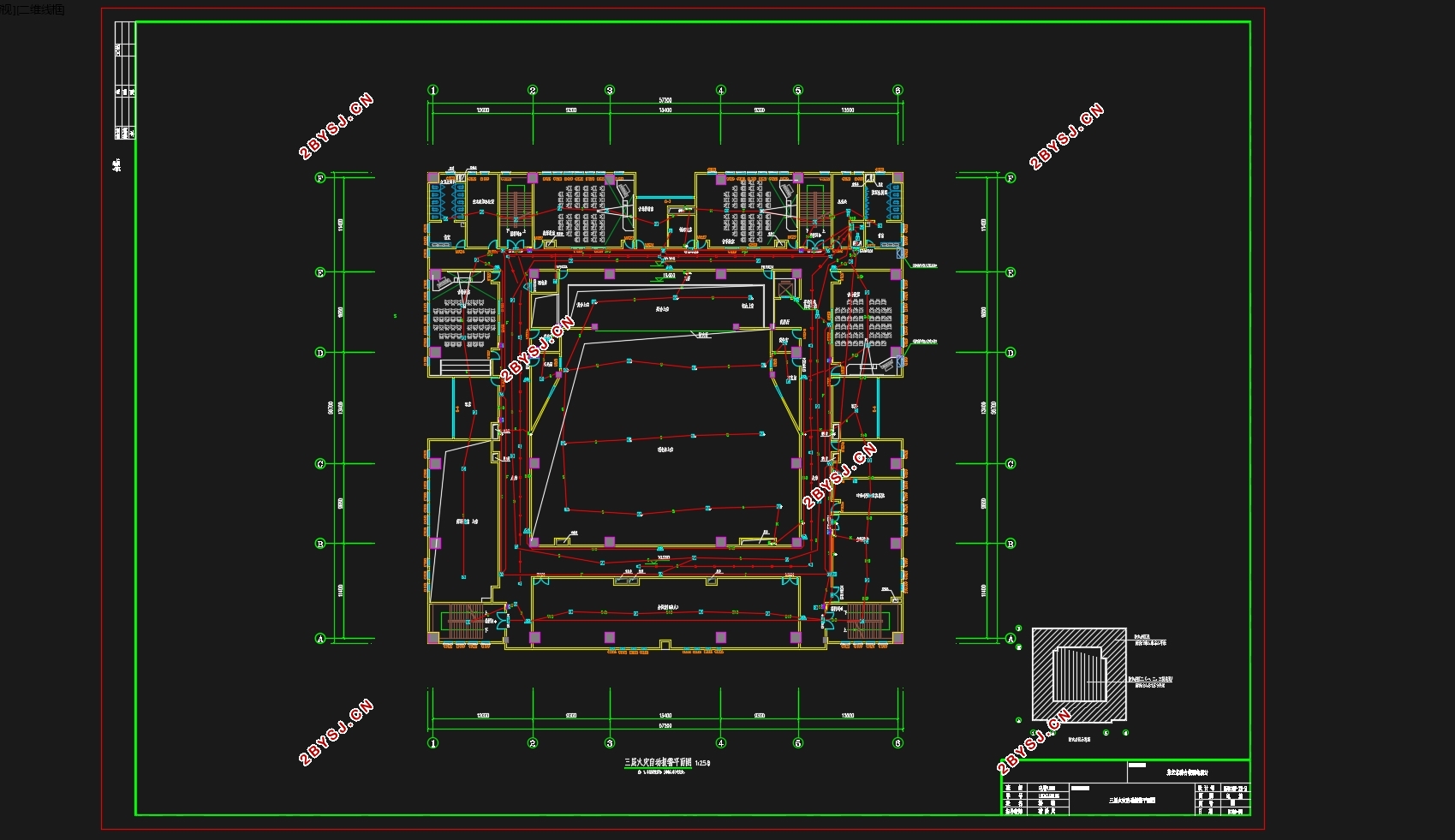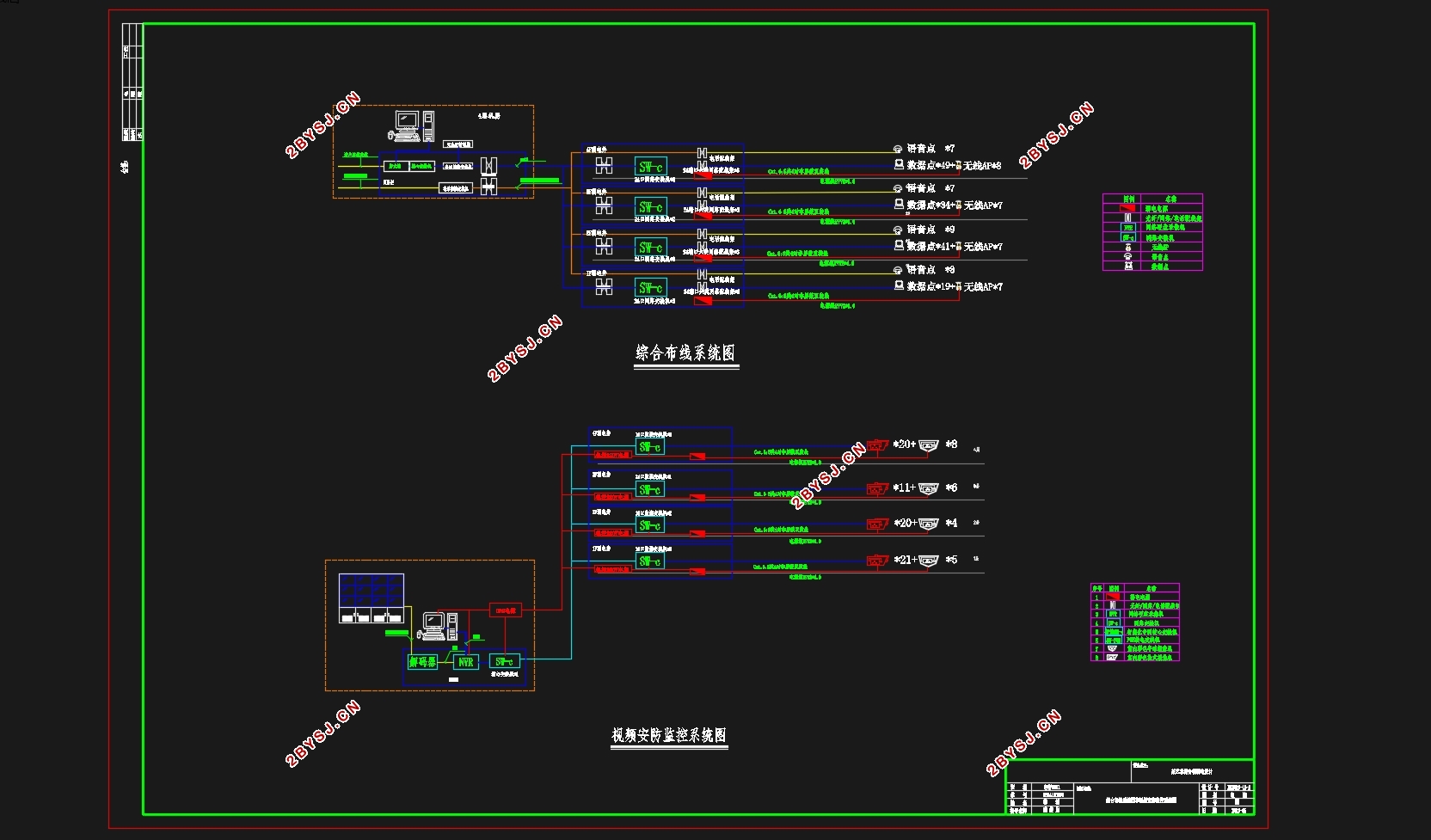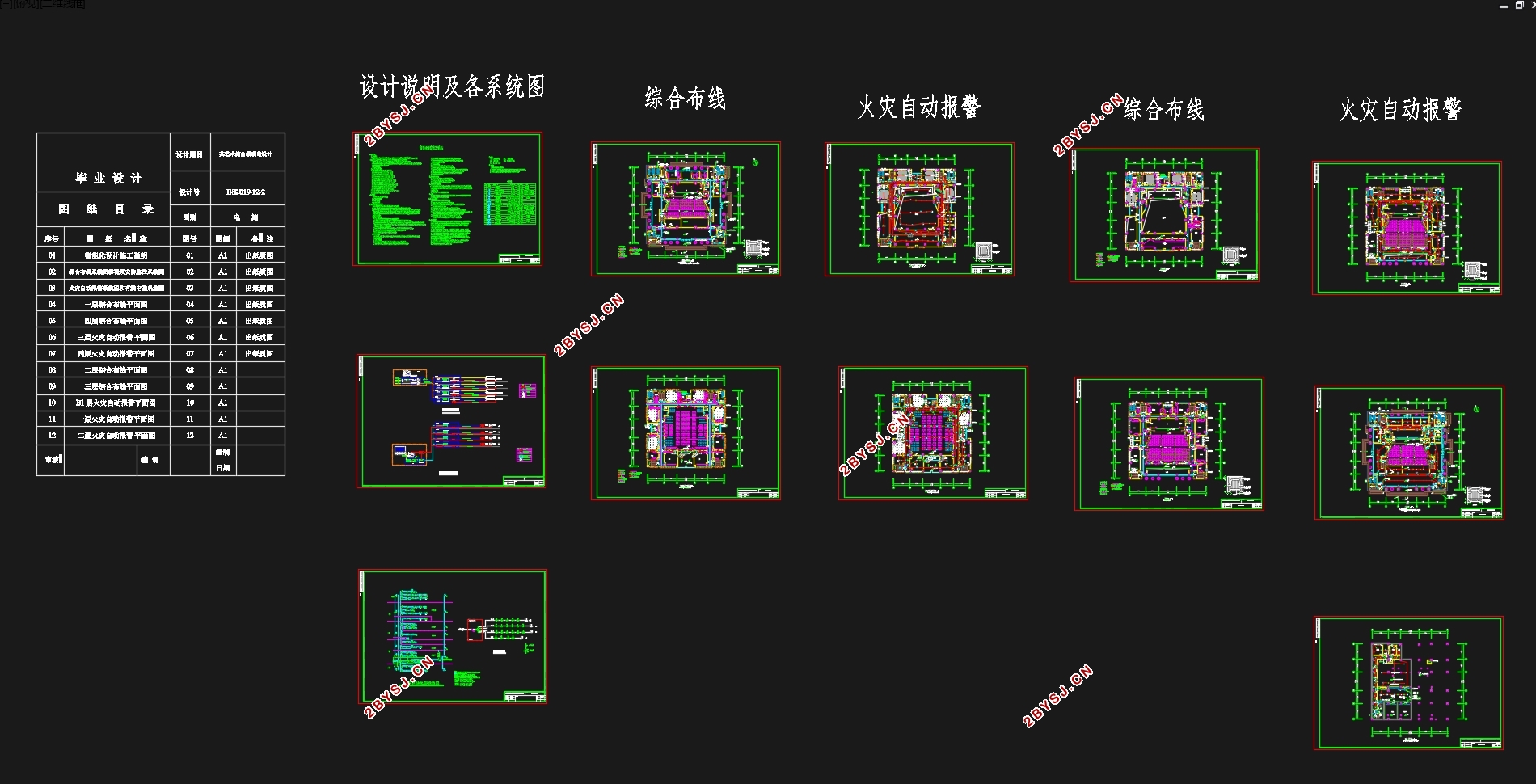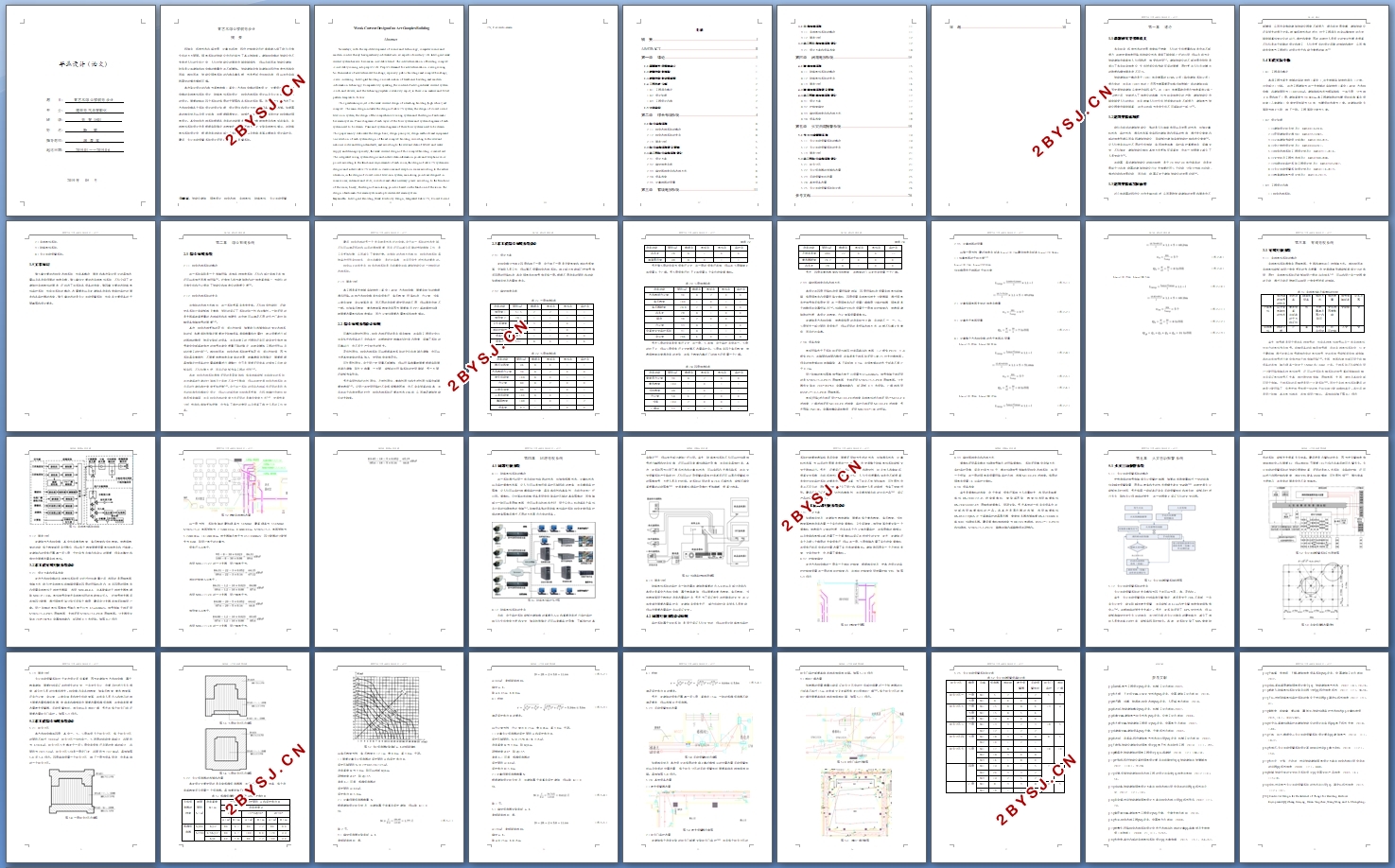某艺术综合楼弱电设计(含CAD图)
无需注册登录,支付后按照提示操作即可获取该资料.
某艺术综合楼弱电设计(含CAD图)(任务书,开题报告,外文翻译,论文说明书11000字,CAD图12张)
摘 要
现如今,科学技术迅猛发展,计算机科学,现代控制理论已经渐渐渗入到了我们日常生活的方方面面。弱电系统的智能化也已经成为了其必然趋势。建筑综合楼的智能化也不免走进人们的生活之中,人们对智能化的需求也越来越强烈,所以目前而言智能化建筑,特别是公共建筑和综合楼的数量也在不断增加。智能建筑由传统建筑与现代信息技术结合而成,相比而言,智能化弱电系统的内容丰富多样,技术更新也比较迅速,所以并没有成熟固定的模式模板可循。
本次毕业设计的内容为某教学楼(高中)艺术综合楼的弱电设计,主要设计包括此综合楼的有线电视系统设计,闭路电视系统设计,综合布线系统设计以及火灾自动报警系统的设计。需要绘制这四个系统的每层的平面图和各系统的系统图。而本论文主要阐述了该艺术综合楼各个系统设计的设计依据,设计原则和设计方法以及设备线型的选择。依据国家的相关规范以及设计标准,并根据暖通专业、给排水专业的相关资料来对此综合楼的弱电设计。其中综合布线系统根据各房间的功能需求设计安装数据信息点和电话语音点;有线电视系统设计也是根据实际情况在教室和接待室等地方设计安装有线电视插口;在闭路电视系统设计中,根据房间功能在部分房间和出入口以及走廊里等必要地点设计监控点;最后,火灾自动报警系统设计采用的是集中式报警系统。
关键词:智能化建筑 弱电设计 综合布线 有线电视 闭路电视 火灾自动报警
Weak Current Design of an Art Complex Building
Abstract
Nowadays, with the rapid development of science and technology, computer science and modern control theory have gradually infiltrated into all aspects of our daily life. Intelligent weak current system has also become an inevitable trend. The intellectualization of building complex is inevitably coming into people's life. People's demand for intellectualization is also growing. So the number of intellectualized buildings, especially public buildings and complex buildings, is also increasing. Intelligent building is a combination of traditional building and modern information technology. Comparatively speaking, the content of intelligent weak current system is rich and diverse, and the technology update is relatively rapid, so there is no mature and fixed pattern template to follow.
This graduation project is the weak current design of a teaching building (high school) art complex. The main design includes the design of cable TV system, the design of closed circuit television system, the design of the comprehensive wiring system and the design of automatic fire alarm system. Plane diagrams of each layer of the four systems and system diagrams of each system need to be drawn. Plane and system diagrams of these four systems need to be drawn. This paper mainly elaborates the design basis, design principles, design methods and equipment line selection of each system design of the art complex building. According to the relevant national codes and design standards, and according to the relevant data of HVAC and water supply and drainage specialty, the weak current design of this complex building is carried out. The integrated wiring system designs and installs data information points and telephone voice points according to the functional requirements of each room; the design of cable TV system also designs and installs cable TV sockets in classrooms and reception rooms according to the actual situation; in the design of closed circuit television system, monitoring points are designed in some rooms, entrances and exits, corridors and other necessary places according to the functions of the room; finally, the design of monitoring points is based on the functions of the room. The design of automatic fire alarm system adopts centralized alarm system.
Keywords:Intelligent Building; Weak Electricity Design; Integrated Cable TV; Closed Circuit TV; Fire Auto-alarm
工程项目概况
本项工程为某大学城的实验学校(高中),与大学城实验学校项目(小学、初中部分)分割。 这次工程建筑为这一大学城的实验学校(高中)-B3# 艺术综合楼,总建筑面积为11485.08m2。建筑结构形式为框架结构,一共五层,分为地上4层和地下1层;建筑高度为30.800m。本工程建筑物的抗震设防标准:重点设防类(乙类建筑),合理使用年限为50年,抗震设防烈度为7度。此建筑的耐火等级为地上二级,地下一级。工程等级分类为二类。






目录
摘 要 I
ABSTRACT II
第一章 绪论 1
1.1课题研究背景和意义 1
1.2建筑智能化现状 1
1.3建筑智能化发展前景 1
1.4工程实况分析 2
1.4.1 工程项目概况 2
1.4.2 设计依据 2
1.4.3 工程设计内容 2
1.5文章布局 3
第二章 综合布线系统 4
2.1 综合布线系统 4
2.1.1 综合布线系统的概念 4
2.1.2 综合布线系统的优点 4
2.1.3 需求分析 5
2.2 综合布线系统设计原则 5
2.3本工程综合布线系统设计 6
2.3.1 设计方案 6
2.3.2 确定信息点表 6
2.3.3 确定缆线走向和布线方式 8
2.3.4 设备选型 8
2.3.5 计算线缆的用量 9
第三章 有线电视系统 11
3.1 有线电视系统 11
3.1.1 有线电视系统的概念 11
3.1.2 需求分析 12
3.2本工程有线电视系统设计 12
3.2.1 设计方案和设备选型 14
第四章 闭路电视系统 15
4.1 闭路电视系统 15
4.1.1 闭路电视系统的概念 15
4.1.2 闭路电视系统的优点 15
4.1.3 需求分析 16
4.2 闭路电视系统设计原则 16
4.3本工程闭路电视系统设计 17
4.3.1 设计方案 17
4.3.2 控制室确定 17
4.3.3 确定缆线走向和布线方式 18
4.3.4 设备选型 18
第五章 火灾自动报警系统 19
5.1 火灾自动报警系统 19
5.1.1 火灾自动报警系统的概念 19
5.1.2 火灾自动报警系统的优点 19
5.1.3 需求分析 21
5.2本工程综合布线系统设计 21
5.2.1 防火分区 21
5.2.2 火灾探测器的选择和布置 22
5.2.3 手动报警按钮布置 25
5.2.4 其他设备布置 25
5.2.5 火灾自动报警系统统计表 26
参考文献 28
致 谢 30
